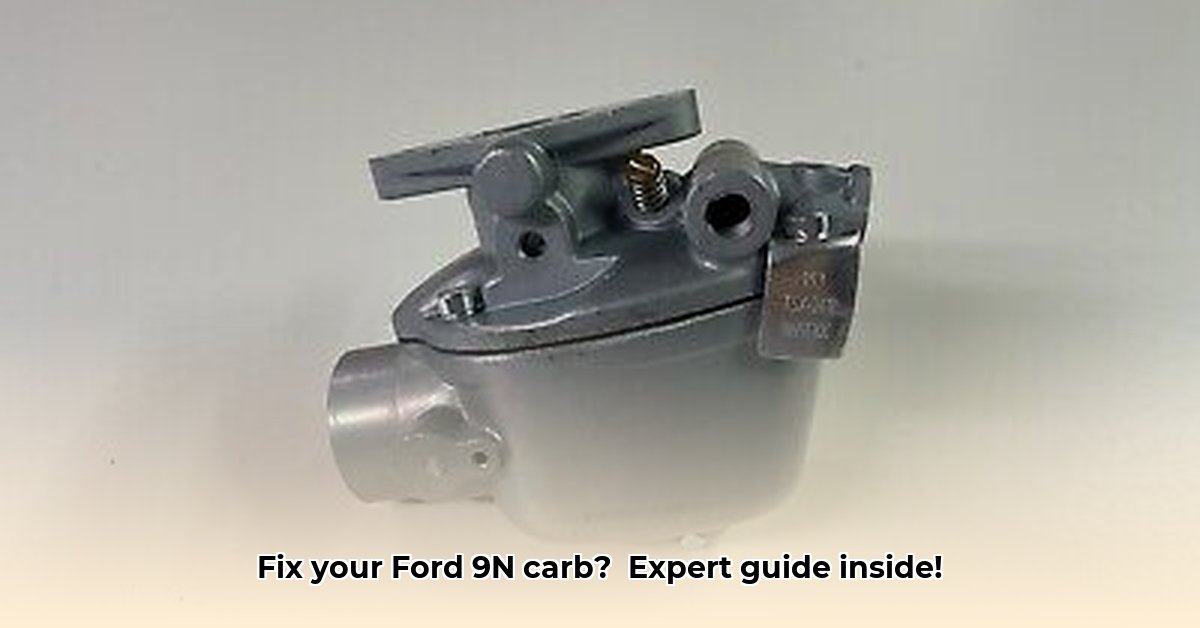
Understanding Your Ford 9N Carburetor
The carburetor on your Ford 9N tractor is responsible for mixing air and fuel for combustion. Two common types are the Marvel-Schebler and Zenith. Common problems include poor starting, rough running, fuel leaks, and stalling. This guide provides a step-by-step approach to troubleshooting and repair, catering to both novice and experienced DIYers. For more info on Ford tractor carburetors, see this helpful guide.
Troubleshooting Your Ford 9N Carburetor
Before diving into repairs, diagnose the issue. This flowchart will help:
graph TD
A[Engine Won't Start] --> B{Fuel in Tank?};
B -- Yes --> C[Check Spark];
B -- No --> D[Fill Tank];
C -- Yes --> E[Check Fuel Lines];
C -- No --> F[Check Ignition System];
E -- Clear --> G[Clean Carburetor];
E -- Clogged --> G;
G --> H[Test Engine];
A --> I[Check Choke];
I --> H;
J[Poor Engine Performance] --> K{Clean Air Filter?};
K -- No --> L[Clean Filter];
K -- Yes --> M[Check Fuel Mixture];
M --> G;
L --> M;
N[Fuel Leaks] --> O[Check Fuel Lines & Connections];
O --> P[Replace Gaskets];
P --> H;
H -- Runs Smoothly --> Q[Success!];
H -- Still Problems --> R[Consider Replacement];
Repairing Your Ford 9N Carburetor: A Step-by-Step Guide
This section details common repairs. High-quality images and diagrams would be included here (not included in this markdown).
Step 1: Preparation
- Gather tools: screwdrivers, wrenches, container for parts, shop rags, carburetor cleaner, compressed air.
- Disconnect fuel lines, ensuring a safe environment; fuel is flammable.
- Take detailed photos of the disassembly process to assist reassembly.
Step 2: Disassembly
Carefully remove the carburetor from the engine and dismantle it. Note the order and orientation of all parts.
Step 3: Cleaning
Thoroughly clean all parts with carburetor cleaner and compressed air focusing on jets and passages.
Step 4: Inspection and Replacement
Inspect parts for wear and tear and replace worn or damaged components. Always use OEM or high-quality aftermarket parts. Replace gaskets and seals regardless of their apparent condition.
Step 5: Reassembly
Carefully reassemble the carburetor using your reference photos. Ensure all parts are securely fastened and in their correct locations.
Step 6: Float Level Adjustment
Adjust the float level according to your tractor's service manual for optimal fuel delivery. Improper adjustments lead to either fuel starvation or flooding.
Step 7: Jet Replacement (if necessary)
Replace any clogged or worn jets with new OEM or high-quality replacements. Incorrect jetting causes imbalance between fuel and air.
Replacing Your Ford 9N Carburetor
If repair is unsuccessful, carburetor replacement may be necessary.
Step 1: Sourcing a Replacement
Choose between OEM (Original Equipment Manufacturer), high-quality aftermarket, or a professionally rebuilt unit. Consider cost, availability, and reliability.
Step 2: Removal
Remove the old carburetor, referencing the disassembly steps above.
Step 3: Installation
Carefully install the new carburetor, ensuring proper fuel and linkage connections.
Step 4: Calibration and Testing
Adjust the throttle and linkages and run the engine, making necessary adjustments for smooth operation.
Sourcing Replacement Parts
Finding the right parts is crucial. Consider these options:
- OEM: Offers the best fit and quality but may be expensive and difficult to find.
- Aftermarket: Often more affordable and readily available, but quality can vary.
- Online Retailers: Convenient, offering wide selections but watch out for shipping times and return policies.
- Local Tractor Repair Shops: Helpful for advice and sourcing hard-to-find parts.
Preventative Maintenance
Regular cleaning and inspections extend the life of your carburetor. This includes cleaning the air filter and checking fuel lines for leaks. Proactive maintenance prevents major repairs and keeps your tractor running smoothly.
Key Takeaways:
- Thorough troubleshooting saves time and effort.
- Cleanliness is paramount in carburetor maintenance.
- OEM parts offer superior reliability, although aftermarket options exist.
- Preventative maintenance is key to long-term performance.
"Regular carburetor maintenance is essential for optimal engine performance and longevity," says John Miller, Master Mechanic at Miller's Tractor Repair. "Ignoring these steps can lead to costly repairs down the road."